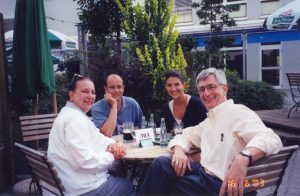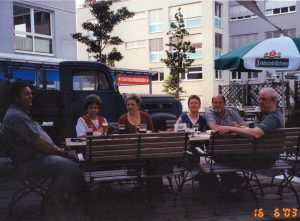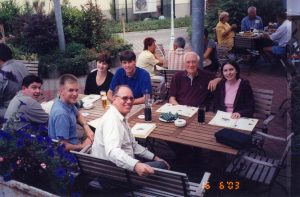Historic Organs of Germany
Dresden, Reinhardtsgrimma, Frauenstein, and Meissen
June 15, 2003
This is another page that’s way too long. In fact, the day itself felt long, because we all traveled around a lot. I’ve added some internal navigation points that should help. I hope they do!
Sunday morning saw the group divide once again, and we prevailed upon the good nature of Dirk Lamy to make sure we all made it to our chosen destinations. Those who didn’t want to go with the organists were driven to Meissen, arriving just in time for the first demonstration of the day at this respected procelain factory. After the demonstration, tour, and a little shopping, they enjoyed this small town, returning to Dresden by train in the afternoon. You can read Judy’s report of their day below. Don’t miss it.
Dresden: Trinity Cathedral
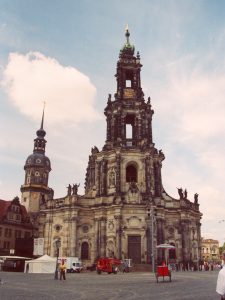 The organists left the bus before Meissen, getting to Trinity Cathedral (formerly the Hofkirche) before the 9:30 Mass. The exterior of this church has more Baroques twists and turns than any building I’ve ever seen, and the “footprint” of the exterior wall almost obscures the basic outline of the rather traditional plan. The exterior, like those of the Zwinger Museum and the Opera House, is dingy, but cleaning some of the buildings has been started.
The organists left the bus before Meissen, getting to Trinity Cathedral (formerly the Hofkirche) before the 9:30 Mass. The exterior of this church has more Baroques twists and turns than any building I’ve ever seen, and the “footprint” of the exterior wall almost obscures the basic outline of the rather traditional plan. The exterior, like those of the Zwinger Museum and the Opera House, is dingy, but cleaning some of the buildings has been started.
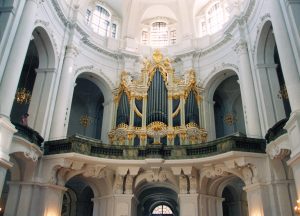 The interior is another matter, however; just look at this photo. The elaborate shape of the exterior is reflected in the shapes of walls and windows, in the Corinthian columns, and in the decorative work that seems to be on every surface. The visual impact is what one would expect from a viewpoint inside an elaborately decorated wedding cake, with frosting applied everywhere. It’s clean, it’s bright white, and large, undecorated flat surfaces are nowhere to be found.
The interior is another matter, however; just look at this photo. The elaborate shape of the exterior is reflected in the shapes of walls and windows, in the Corinthian columns, and in the decorative work that seems to be on every surface. The visual impact is what one would expect from a viewpoint inside an elaborately decorated wedding cake, with frosting applied everywhere. It’s clean, it’s bright white, and large, undecorated flat surfaces are nowhere to be found.
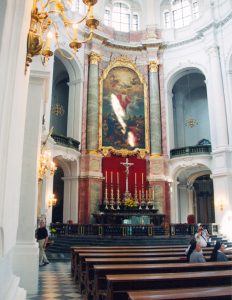 Although we had learned the night before that Kathedral Organist Hansjürgen Scholze had other appointments and could not give us an Orgeleinführung, we had two treats for our ears that morning. The first was unrelated to the organ at all, because the bells rang for about ten minutes before the start of Mass. The sound of those huge bells ringing for so long was incredible! I’m sure I’ll never forget the physical sensation of having those different pitches pile up on one another, then change as some pitches (and their overtones) faded while others increased in strength. It was an experience I’ve never had before—at least not to that degree.
Although we had learned the night before that Kathedral Organist Hansjürgen Scholze had other appointments and could not give us an Orgeleinführung, we had two treats for our ears that morning. The first was unrelated to the organ at all, because the bells rang for about ten minutes before the start of Mass. The sound of those huge bells ringing for so long was incredible! I’m sure I’ll never forget the physical sensation of having those different pitches pile up on one another, then change as some pitches (and their overtones) faded while others increased in strength. It was an experience I’ve never had before—at least not to that degree.
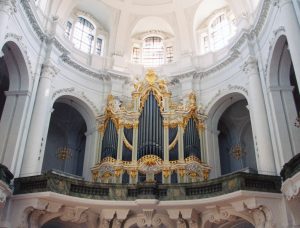 The second treat was the sound of the organ. This was our first chance to hear a Silbermann instrument, and we all agreed that the sound was indeed “silvery.” Of course, without knowing what stops were used at any given point, we could have misunderstood easily what we were hearing, but the overall effect in the room was quite stunning, especially in contrast to the Sauer of the Berlinerdom, which we had also heard in use in a service the day before. Another aspect that limited our understanding of what we were hearing concerned our active participation. When we sang, we couldn’t hear the organ independently of our own voices. On the other hand, if we didn’t sing, we weren’t hearing the instrument the way we should either. It’s always the same in circumstances like this, but it was particularly frustrating since we would have no other opportunity to hear this instrument.
The second treat was the sound of the organ. This was our first chance to hear a Silbermann instrument, and we all agreed that the sound was indeed “silvery.” Of course, without knowing what stops were used at any given point, we could have misunderstood easily what we were hearing, but the overall effect in the room was quite stunning, especially in contrast to the Sauer of the Berlinerdom, which we had also heard in use in a service the day before. Another aspect that limited our understanding of what we were hearing concerned our active participation. When we sang, we couldn’t hear the organ independently of our own voices. On the other hand, if we didn’t sing, we weren’t hearing the instrument the way we should either. It’s always the same in circumstances like this, but it was particularly frustrating since we would have no other opportunity to hear this instrument.
During Communion, however, as Herr Scholze improvised in a French classic style, we clearly heard the influence of Andreas Silbermann on his brother Gottfried’s work. Though the reeds were tamer than they became in late eighteenth-century France, they were definitely French in color and size. We knew then we were longer in North Germany!
Reinhardstgrimma: Dorfkirche
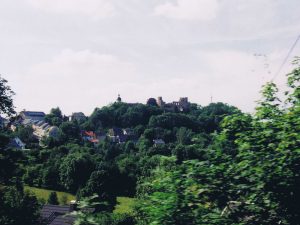 One of the great joys of taking a trip like this one is found in the opportunity to leave the beaten “tourist” path, go outside the major cities, and see something of the countryside and small towns. The rest of Sunday offered us the chance to do just that, as we left Dresden and headed first for Reinshardtsgrimma. With hardly space to turn the bus around, the village is quite small and nestled among the rolling hills of lower Saxony. The cemetery beside the village church was well tended, and most graves, some of them quite old, had blooming plants around and beside the stone markers. We arrived early enough to hear the end of the morning service as we stood in the church yard. After the service we were welcomed by the Pastor, who introduced us to Herr Friedrich Hahmann, who then proceeded to give us a fine introduction to and demonstration of their Silbermann organ of 1731.
One of the great joys of taking a trip like this one is found in the opportunity to leave the beaten “tourist” path, go outside the major cities, and see something of the countryside and small towns. The rest of Sunday offered us the chance to do just that, as we left Dresden and headed first for Reinshardtsgrimma. With hardly space to turn the bus around, the village is quite small and nestled among the rolling hills of lower Saxony. The cemetery beside the village church was well tended, and most graves, some of them quite old, had blooming plants around and beside the stone markers. We arrived early enough to hear the end of the morning service as we stood in the church yard. After the service we were welcomed by the Pastor, who introduced us to Herr Friedrich Hahmann, who then proceeded to give us a fine introduction to and demonstration of their Silbermann organ of 1731.
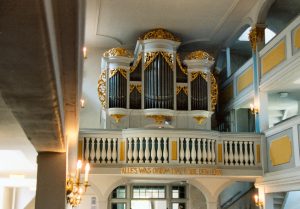 The church itself is charming. The altar seems almost too ornate for the rest of the room, which is almost completely without added ornamentation. One feature I noticed, which we would continue to see in many contexts, was the inscription on the base of the organ gallery: the final verse of Psalm 150, “Alles was odem hat lobe den Herrn.” In the King James translation, the verse reads “Let every thing that hath breath praise the Lord.”
The church itself is charming. The altar seems almost too ornate for the rest of the room, which is almost completely without added ornamentation. One feature I noticed, which we would continue to see in many contexts, was the inscription on the base of the organ gallery: the final verse of Psalm 150, “Alles was odem hat lobe den Herrn.” In the King James translation, the verse reads “Let every thing that hath breath praise the Lord.”
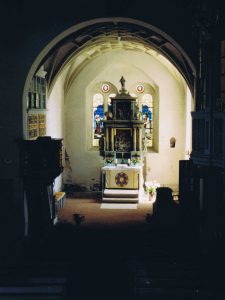 The instrument surprised me a little with the sound of its chorus. After all, we had just left the magnificent space of Trinity Cathedral, and here we were in a small village church, with its narrow space further confined by the double tiered gallery along each side of the nave. The sound of what I think of as an “English” chorus, 8′, 4′, 2 2/3′ and 2′, was really strong, and the addition of the Mixture IV produced a true “wall” of sound not unlike what I heard in the Schnitger organs. The flutes, too, were big, clear, and bright, and the Nassat-Tertia combination on the Oberwerk (which really is a Hinterwerk, because the chest is behind, not above the Hauptwerk) was brighter than I expected, with each stop easily distinguished from the others. This was in contrast to the Prinzipal-Nasat combinations of the Schintger organs we had played in the north. The pedal reed, however, produced a sound I had longed for since our arrival. It was big, very fundamental, without any buzz or rattle, and I would love to have it in any acoustically dry church, large or small, in which I’ve played in the US. We should all be so fortunate as to have stops of this beautiful tonal quality.
The instrument surprised me a little with the sound of its chorus. After all, we had just left the magnificent space of Trinity Cathedral, and here we were in a small village church, with its narrow space further confined by the double tiered gallery along each side of the nave. The sound of what I think of as an “English” chorus, 8′, 4′, 2 2/3′ and 2′, was really strong, and the addition of the Mixture IV produced a true “wall” of sound not unlike what I heard in the Schnitger organs. The flutes, too, were big, clear, and bright, and the Nassat-Tertia combination on the Oberwerk (which really is a Hinterwerk, because the chest is behind, not above the Hauptwerk) was brighter than I expected, with each stop easily distinguished from the others. This was in contrast to the Prinzipal-Nasat combinations of the Schintger organs we had played in the north. The pedal reed, however, produced a sound I had longed for since our arrival. It was big, very fundamental, without any buzz or rattle, and I would love to have it in any acoustically dry church, large or small, in which I’ve played in the US. We should all be so fortunate as to have stops of this beautiful tonal quality.
 I had only one difficulty playing this organ: the bench couldn’t be moved back far enough. The gallery isn’t very large, and with the shorter length of pedals my big feet could hardly fit in the space. There was no way I could get a heel on the naturals without having my toes held up above the sharps. “Toes only” pedaling was the way to go here!
I had only one difficulty playing this organ: the bench couldn’t be moved back far enough. The gallery isn’t very large, and with the shorter length of pedals my big feet could hardly fit in the space. There was no way I could get a heel on the naturals without having my toes held up above the sharps. “Toes only” pedaling was the way to go here!
Frauenstein
After we had an opportunity to play the Reinhardtsgrimma organ ourselves, we moved on to Frauenstein,
birthplace of Gottfried Silbermann, just in time for a late lunch at the “Goldene Stern.” Some of us sat outdoors and enjoyed looking around this small town, while most of the group sat indoors and enjoyed the hospitality of this excellent family-run inn and restaurant. After a leisurely meal, we walked up the hill to spend some time in the Silbarmann museum. We played the small instrument in the main hall, enjoyed the exhibits of organ-builder’s tools, and (inevitably) made a few purchases.
Soon, though, we left the museum, returned to the bus, and after another pleasant ride through the beautiful countryside, returned to meet the rest of our group at our Dresden hotel.
Dinner was once again a treat at the restaurant next door, located in the former headquarters of a local brewery. The tables were outdoors, the weather was fine, and the beer was great. Conversations alternated between reports of our different activities for the day and speculations about the next day, as we contemplated the day in Freiberg that the morning would bring.
A Day Trip to Meissen
Germany is known for great and wondrous things, many of which we were fortunate to see, taste, hear, and experience on this trip. Ever the adventurer, I volunteered to lead an expedition for those who wanted to round out the trip with a visit to the porcelain factory of Meissen. I was somewhat familiar with the upscale porcelain and knew we would enjoy the museum and shop as well as the factory tour. I also had a few Euro’s in my pocket and looked forward to a souvenir or two. Those blue crossed swords are pretty impressive in the states.
We began the trip bright and early, settling ourselves on the bus for the 40 minute ride to the small village where the factory had been in operation for many, many years. Up into the hills, through absolutely gorgeous, almost lush forests, past farms and charming homes we travelled with Dirk assuring us he knew the way. I had looked on my map, and had thought we would travel there on the autobahn, but no – a much lovelier road made the trip much more enjoyable for me. We arrived at the factory, said our good-bye’s and thank-you’s to Dirk, and assured him we could find our way home later in the day since the bus would be needed for the others to visit several organs that day.
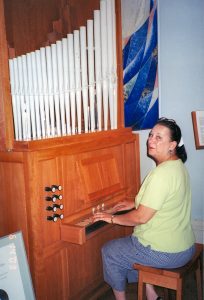 We arrived just in time to purchase our tickets (at the desk they “guessed” we were English speaking; with me buying the tickets, I can’t imagine why) and graciously led us to the first group tour of the day. Each of us was given headphones, and the entire tour was translated over these into English. We moved through four or five rooms and in each, an artisan was demonstrating a technique – pottery wheel, molds, sculpting, painting, etc. – which led to the eventual product. I was transfixed at the artistry each technique demanded, and enchanted by the narrative that explained what we were seeing. Beautiful shapes for vases and urns, delicate molds for tiny heads and flowers, fine detail painting for costumes, fruits, and all manner of decorations. Fascinating! After the tour, we surrendered our headphones and wandered the lovely display hall back to the lobby. Spotting the cafe, we headed in to compare notes and decide what to do next.
We arrived just in time to purchase our tickets (at the desk they “guessed” we were English speaking; with me buying the tickets, I can’t imagine why) and graciously led us to the first group tour of the day. Each of us was given headphones, and the entire tour was translated over these into English. We moved through four or five rooms and in each, an artisan was demonstrating a technique – pottery wheel, molds, sculpting, painting, etc. – which led to the eventual product. I was transfixed at the artistry each technique demanded, and enchanted by the narrative that explained what we were seeing. Beautiful shapes for vases and urns, delicate molds for tiny heads and flowers, fine detail painting for costumes, fruits, and all manner of decorations. Fascinating! After the tour, we surrendered our headphones and wandered the lovely display hall back to the lobby. Spotting the cafe, we headed in to compare notes and decide what to do next.
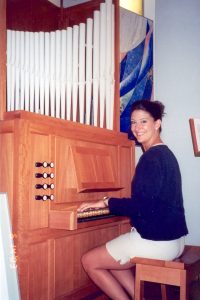 Reading the material given us at the door, we decided to wander in the museum next. It was three floors devoted to the history of Meissen with displays of every conceivable pattern, color, design, style and shape of dishes, cups, figurines, animals, urns, vases, and any other sculptural form you could imagine, and some you couldn’t. Ranging in size from miniscule up, the beautiful pieces continued to amaze and delight us. Expecting the usual dinnerware and decorative figurines, I was surprised to learn that many famous artists (Picasso being one) had designed for Meissen. Our eyes had about “glazed” over at this point. Lo and behold, we came upon an organ with porcelain pipes. Now, being with a group who knew the others were off doing “important historical research on organs,” we were not about to let this opportunity pass us by. KC and I managed to convince a guard that we should be allowed to be photographed “playing” this unique instrument. With much laughter from the guards and the other visitors, we mimed playing and had our photograph taken. Marilyn is the keeper of this treasure, and I haven’t seen it yet, but I’m sure we’ll be famous for our unique style, or at least for our audacity.
Reading the material given us at the door, we decided to wander in the museum next. It was three floors devoted to the history of Meissen with displays of every conceivable pattern, color, design, style and shape of dishes, cups, figurines, animals, urns, vases, and any other sculptural form you could imagine, and some you couldn’t. Ranging in size from miniscule up, the beautiful pieces continued to amaze and delight us. Expecting the usual dinnerware and decorative figurines, I was surprised to learn that many famous artists (Picasso being one) had designed for Meissen. Our eyes had about “glazed” over at this point. Lo and behold, we came upon an organ with porcelain pipes. Now, being with a group who knew the others were off doing “important historical research on organs,” we were not about to let this opportunity pass us by. KC and I managed to convince a guard that we should be allowed to be photographed “playing” this unique instrument. With much laughter from the guards and the other visitors, we mimed playing and had our photograph taken. Marilyn is the keeper of this treasure, and I haven’t seen it yet, but I’m sure we’ll be famous for our unique style, or at least for our audacity.
Finally reaching the top floor of the museum (it is really too much to take in) we decided to head for the shop. It was quickly apparent that my few Euro’s wouldn’t go far, but everyone who wanted to buy found something to take home. Because I collect bells and nativity scenes, I found a beautiful bell with the annunciation and the nativity embossed on it. I decided to afford it, and it was beautifully wrapped for the trip to my American shelves. Finally the group had finished looking/shopping and we gathered outside to figure out how to get “home.”
After asking the helpful ticket lady how to reach the train station, I determined we could walk twenty minutes just down the street, or wait for a bus around the corner. My feet said, “wait for the bus,” so we rounded the corner and found a bus stop. Not knowing which bus to take confounded us for a while, but fortunately we were across from a park where people were sitting in the sun. Having a choice of asking a couple suffering from lip-lock or two drunks toasting the morning, Richard Ward and I walked across the park and spoke with the drunks. He and his ability to speak German were comforting to me, and he soon ascertained that the busses all went to the train station, so we headed back just in time to see the bus pull up and stop for our attractive group. We rode through the town (happy we had not chosen to walk) and found the train station. Ever the adventuresome group, we decided we could get a train later and decided to find some lunch. KC noticed a hotel across the street and persuaded us it would be better than the “stand-up” fare in the station. Boy! Was she right.
Entering the hotel and dark lovely dining room, we were greeted and seated at a beautifully set table. From our observation, it was obvious that we made their day as far as sales were concerned. Not many others came in while we were there. What a lunch! Many of us took advantage of “asparagus season” and had dishes of the wonderful white spears. Everyone agreed the food was outstanding. With much talk and laughter, we recounted the morning’s sights and relaxed in comfort before continuing our travels. We sent the brave Richard back across to the station, and he found the train times, and in fact bought all our tickets so we didn’t have to struggle with the language. Re-imbursing him, we thanked him for his on-going courtesies, and toasted him a time or two, if I recall correctly.
Finally, it was time to leave and we found our way to the track where we thought we were catching a non-stop train back home. Unfortunately, it stopped at every village on the way, but we spoke with some nice college age kids (who spoke English beautifully) and they reassured us were on the right “track.” Finally arriving at our destination, we unloaded and began the trek to our hotel. Marilyn, probably wisely, opted for a taxi, but the rest of us decided to walk. It was several blocks, but all through a lovely neighborhood of shaded lawns, old homes, and sun-dappled sidewalks. Leisurely making our way, we found it the perfect end to a great day. One would think I had planned it all! One would be wrong. I am just lucky!
Journal Entry
June 15 Rheinhardtsgrimma was an adorable little community–almost too perfect, actually. The homes had perfectly manicured lawns, no litter was to be seen, and in the middle of the village was this perfect fairy tale-like church. The church was surrounded by graves that were also well manicured, all with flowers planted on top of the gravesites. Inside this small church was truly the most perfect little pipe organ I have ever seen. It produced a very charming sound– ethereal to the ear, with a sound that was neither buzzing nor too quiet. The sound of Silbermann organs has been described as “silvery.” Indeed, “silvery” is a good term to use! This organ produced a sound that filled the room nicely– the sound was neither too timid, nor to overpowering. I was, however, surprised at how difficult it was to play the pedals on this particular instrument. The pedals were spaced so far apart, even more so, it seemed to me, than other organs I played in Germany. The manual action was not so difficult–I would describe it as just the same as the other German organs: tougher
than our American organs, but on par with other German organs I played. Truly an amazing experience (and a lot of fun, too)!

